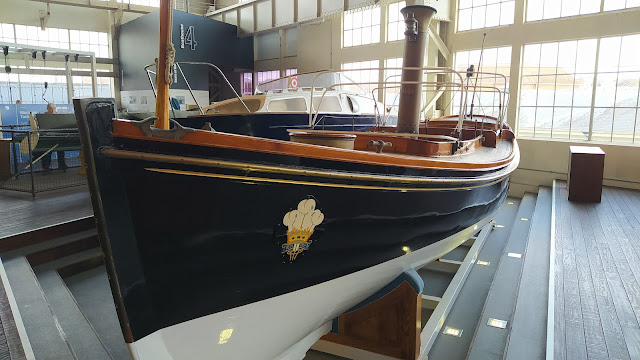The Historic Dockyard at Portsmouth is a naval museum dedicated to the glory days of the British Royal Navy. Its most famous exhibit is arguably HMS Victory, that served as Lord Nelson's flagship during the Battle of Trafalgar.
The museum is located next door to Portsmouth Naval Base, so with a bit of luck, you can also get a glimpse of the Navy's current fleet of aircraft carriers.
HMS Warrior
This was the Royal Navy's first steel hulled fighting ship, launched in 1860. Although it still retains sails, it is steam powered. The super-carrier of its day at the height of the British Empire.
 |
| As a fighting ship, it would also carry a contingent of naval infantry, hence the large number of firearms on board. |
 |
| Cap and ball revolvers. |
 |
| The officer's quarters are quite luxurious compared to the rest of the ship. |
 |
| The main weaponry consisted of naval guns, of course. |
 |
| Note the swinging bed. |
 |
| The boiler room. |
 |
| The engine room. |
Boathouse No. 4
 |
| An active workshop where a lot of the restoration work takes place. |
HMS M.33
 |
| Just over the barbed-wired fence, the HMS Queen Elizabeth aircraft carrier is loaded with supplies. |
 |
| The carrier in the distance is the current flagship of the Royal Navy, the HMS Prince of Wales. |
 |
| HMS Prince of Wales |
 |
| HMS Queen Elizabeth |
HMS Victory
Britain's most celebrated warship, the victor of Trafalgar.
 |
| Lord Nelson's sleeping cabin. He wasn't a very tall fellow. |
The Royal Navy Submarine Museum
The submarine museum is on the opposite side of the harbor. A short waterbus ride is included in the admission price. It is worth it for the ride alone, the submarines are an added bonus.
 |
| An early submersible experiment. |
 |
| Basically a wooden barrel with a hand-cranked propeller. Very ingenious for its day. |
HMS Alliance - Diesel-Electric Submarine
 |
| The Alliance served as the Navy's school submarine for decades. |
 |
| As a diesel-electric submarine it became obsolete early in its service life, but it remained perfectly suited to training purposes. |
 |
| Here you can observe the propeller on the back end of a torpedo. |
 |
| The driver's seat... |
 |
| ... and the other driver's seat. One controls the depth of the vessel, the other the speed and direction (heading). |
 |
| The only washroom for the 70 odd crew. |
Holland I Submarine
The Royal Navy's first - launched in 1901. And yes, it had batteries!
THE END.


































































































